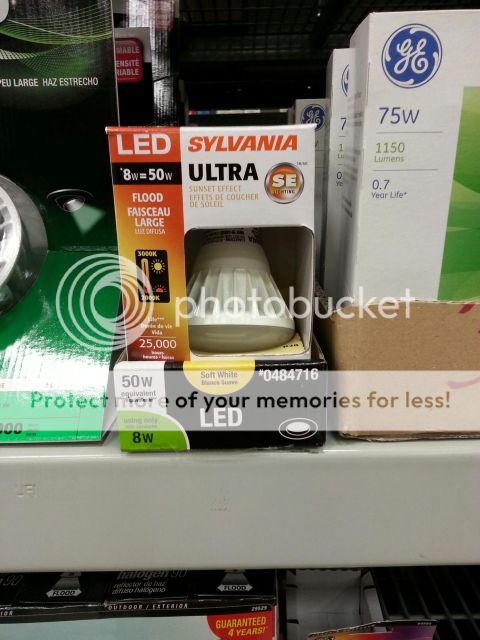yuandrew
Flashlight Enthusiast
Most LED lamps either retain the same color temperature or acquire a cooler light when dimmed. Earlier this year, Osram/Sylvania introduced their "Sunset Effect" (SE) series of led reflector lamps which supposedly get a warmer color temperature (3000k-2000k) when dimmed.
https://www.sylvania.com/en-us/products/solid.../ULTRA-SE.aspx

These first appeared at the Lowe's in my area around October but only recently did they put up an end-cap display exclusively featuring these lamps. They are all reflector lamps consisting of R-20 (shown), R-30, and R-40 sizes. The display at my store had two recessed cans connected to the same dimmer (Lutron Diva C.L.) with a regular LED in one and the Sunset Effect LED in the other for comparison.
I played with the dimmer for a while to see how it worked and it looks like what Sylvania did was incorporate some orange LEDs into the lamp that operated at the lower levels. On full brightness, it seemed that only the main "White" LEDs were lit but when the dimmer was turned down slightly, the orange LEDs came on giving the lamp an increasingly pinkish-red tint as it dimmed. At the lower levels (below the 30% setting), the lamp began to take on a more orange color then the white LEDs shut off completely at around the lowest setting on the dimmer leaving just the plain orange LEDs; the color reminding me of a Low-Pressure sodium lamp.
The concept goes back a little further. I read an article on outdoor lighting design and guidelines for Yosemite National Park dated May 2011 and one of the items they mentioned was "adaptive LED technology" which blended 2700K or 3000K white LEDs with red and orange LEDs in a single array for use in dusk to dawn fixtures. The light would come on at dusk with the white LEDs then over the course of two to three hours, a timer circuit would "fade out" the white LEDs while "fading in" the red/orange LED mix until only the orange light remained for the rest of the night; the idea being the lower colored lighting would reduce light pollution and wildlife impact in the later-hours.
http://www.nps.gov/yose/naturescience/upload/Lighting-Guidlines-05062011.pdf (PFD File, read page 8)
https://www.sylvania.com/en-us/products/solid.../ULTRA-SE.aspx

These first appeared at the Lowe's in my area around October but only recently did they put up an end-cap display exclusively featuring these lamps. They are all reflector lamps consisting of R-20 (shown), R-30, and R-40 sizes. The display at my store had two recessed cans connected to the same dimmer (Lutron Diva C.L.) with a regular LED in one and the Sunset Effect LED in the other for comparison.
I played with the dimmer for a while to see how it worked and it looks like what Sylvania did was incorporate some orange LEDs into the lamp that operated at the lower levels. On full brightness, it seemed that only the main "White" LEDs were lit but when the dimmer was turned down slightly, the orange LEDs came on giving the lamp an increasingly pinkish-red tint as it dimmed. At the lower levels (below the 30% setting), the lamp began to take on a more orange color then the white LEDs shut off completely at around the lowest setting on the dimmer leaving just the plain orange LEDs; the color reminding me of a Low-Pressure sodium lamp.
The concept goes back a little further. I read an article on outdoor lighting design and guidelines for Yosemite National Park dated May 2011 and one of the items they mentioned was "adaptive LED technology" which blended 2700K or 3000K white LEDs with red and orange LEDs in a single array for use in dusk to dawn fixtures. The light would come on at dusk with the white LEDs then over the course of two to three hours, a timer circuit would "fade out" the white LEDs while "fading in" the red/orange LED mix until only the orange light remained for the rest of the night; the idea being the lower colored lighting would reduce light pollution and wildlife impact in the later-hours.
http://www.nps.gov/yose/naturescience/upload/Lighting-Guidlines-05062011.pdf (PFD File, read page 8)
Last edited:

